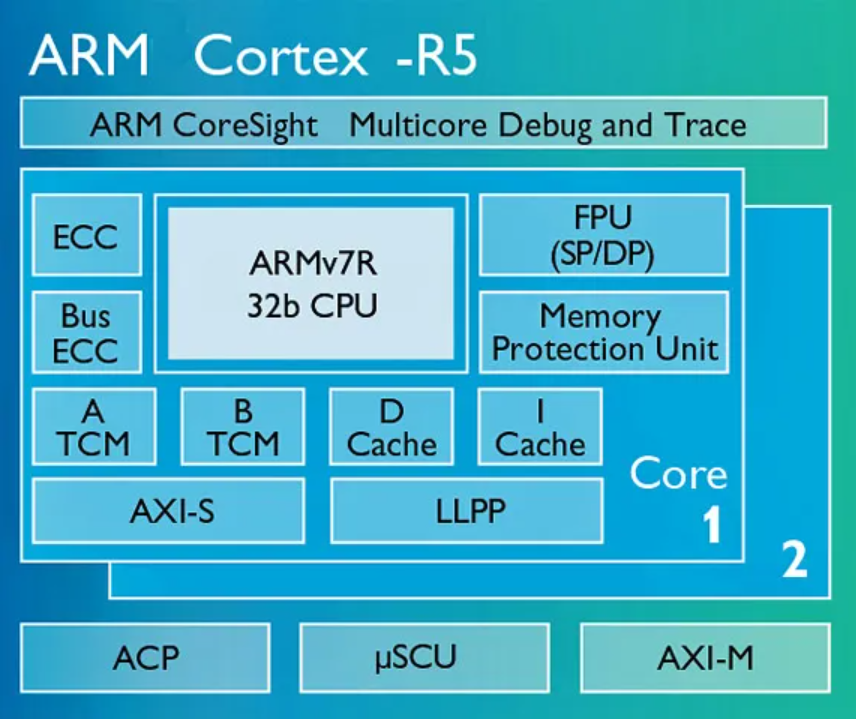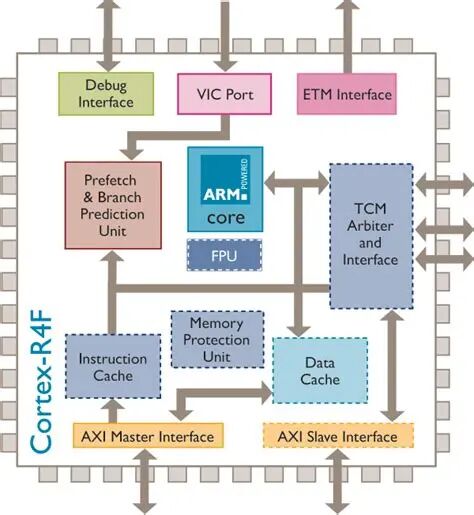The Cortex-R5F is a real-time processor core based on the ARMv7-R architecture, designed for embedded systems that require high reliability and low latency. It is widely used in industrial automation, automotive electronics, and intelligent control.The core advantage of the Cortex-R5F lies in its low latency interrupt handling capability, enabling rapid response to external events while supporting various peripheral interfaces such as CAN, UART, GPIO, etc. to meet the real-time input and output requirements in industrial control. The Cortex-R5F has a maximum frequency of 800MHz, a processing power of up to 6400 DMIPS, and features 32KB ICache, 32KB DCache, and 64KB TCM, making it more efficient and stable in handling real-time tasks.
1. Architecture and Core Features
The Cortex-R5F is a variant of the ARM Cortex-R5 series processors, based on the ARMv7-R architecture, and supports Thumb-2 technology to achieve efficient code density and processing throughput. It employs a single arithmetic logic unit (ALU) but supports limited dual-issue instructions to enhance resource utilization. Additionally, the Cortex-R5F supports low interrupt latency by loading multiple instructions through interrupts and restarts, utilizing dedicated peripheral ports for low-latency access to the interrupt controller.


2. Memory System
The Cortex-R5F features a Harvard architecture cache system, including separate L1 instruction and data caches (each 16KB). It is also equipped with tightly coupled memory (TCM), providing low-latency deterministic access. Each Cortex-R5F core has two 64KB TCM banks, totaling 128KB, for storing instructions and data to reduce cache misses. TCM supports ECC (Error Correction Code) protection to enhance reliability.
3. Multi-core and Operating Modes
The Cortex-R5F can be configured in dual-core or lock-step mode. In dual-core mode, the two cores operate independently, while in lock-step mode, the second core runs as a mirror of the first core, sharing TCM and not using caches or interrupts. This mode is suitable for safety-critical applications that require high reliability.
4. Floating Point Operations and Extended Features
The Cortex-R5F can be optionally equipped with a floating-point unit (FPU) to support floating-point operations. Additionally, it supports the VFPv3-D16 instruction set in the Armv7-R architecture, providing efficient floating-point computation capabilities.
5. Security and Reliability
The Cortex-R5F supports safety-critical applications, including a Cryptographic Hardware Security Module (CHSM) and a Memory Protection Unit (MPU). The MPU can partition memory into multiple regions, each with independent protection attributes. Furthermore, the Cortex-R5F supports ECC protection to detect and correct errors in memory, ensuring data integrity and system reliability.
6. Application Areas
The Cortex-R5F is widely used in industrial automation, automotive electronics, and intelligent control. For example, in industrial automation, the Cortex-R5F works in conjunction with a dual-core Cortex-A53 main core to provide high real-time processing capabilities. In automotive electronics, the Cortex-R5F is used to handle safety protocols and encryption algorithms, ensuring the security of in-vehicle communications.
7. Performance and Power Consumption
The Cortex-R5F has a maximum frequency of 800MHz, with single-core performance of 1,600 DMIPS and dual-core performance of 3,200 DMIPS. It supports various power management modes, from active to shutdown, to reduce power consumption. Additionally, the Cortex-R5F supports low-power modes to accommodate the needs of different application scenarios.
8. Development and Debugging
The Cortex-R5F supports the standard Arm CoreSight™ debugging and tracing architecture, providing an integrated Vector Interrupt Manager (VIM) and Performance Monitoring Unit (PMU). These features enable developers to easily perform debugging and performance analysis.
